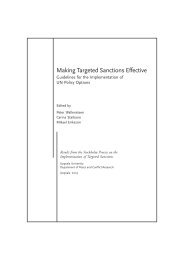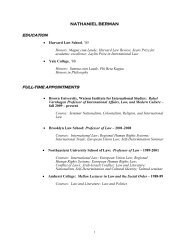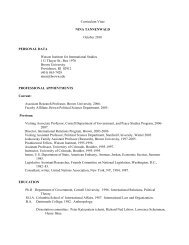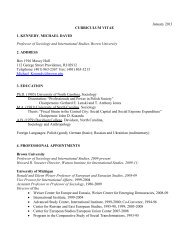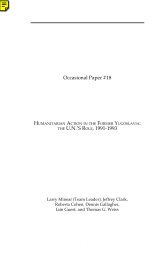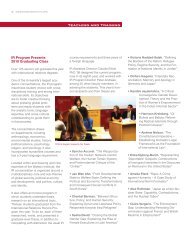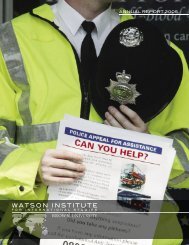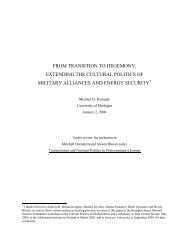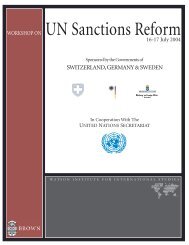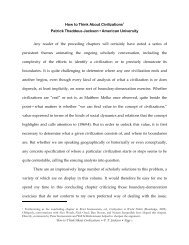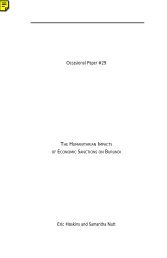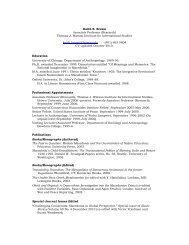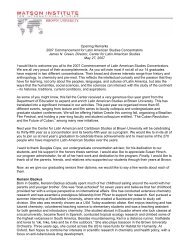a guide to peace support operations - The Watson Institute for ...
a guide to peace support operations - The Watson Institute for ...
a guide to peace support operations - The Watson Institute for ...
You also want an ePaper? Increase the reach of your titles
YUMPU automatically turns print PDFs into web optimized ePapers that Google loves.
Part II, Section 1, paragraphs 3-4<br />
assistance during conflict: when there is no host government, when<br />
several competing authorities claim the right <strong>to</strong> govern, or when a<br />
vic<strong>to</strong>rious guerrilla <strong>for</strong>ce seeks revenge against those who opposed it.<br />
Previous experience provides few insights in<strong>to</strong> the complexities of the<br />
next crisis. <strong>The</strong>re is a sense that the humanitarian network is always<br />
one step behind a crisis or fighting the new war with the strategy and<br />
tactics of the previous one, exacerbated by the unpredictable and<br />
rapidly changing nature of emergencies.<br />
(3) Resourcing New Roles<br />
Complex emergencies introduce issues beyond the mandates or capacities<br />
of most agencies. Demining and demobilization activities are<br />
two examples. <strong>The</strong> list of new activities has grown and expanded the<br />
concept of “humanitarian aid.” More and more humanitarian aid is<br />
seen as an instrument <strong>to</strong> provide “relief” <strong>for</strong> fragile societies that, if<br />
not assisted quickly, may slide back in<strong>to</strong> conflict. Humanitarian aid<br />
there<strong>for</strong>e may encompass such post-conflict recovery activities as<br />
constructing military barracks, establishing police <strong>for</strong>ces, and even<br />
building prisons. None of these activities has ever been seen as<br />
conventionally “humanitarian,” but without them, there may be only<br />
the prospect of more violence. <strong>The</strong> need <strong>to</strong> deal with a growing number<br />
of different activities has not led <strong>to</strong> a clarification of UN agency<br />
mandates and capabilities. This lack of clarity encourages confusion<br />
and competition <strong>for</strong> “turf” or institutional terri<strong>to</strong>ry. When mandates<br />
are not clear, the fight <strong>for</strong> turf is inevitable.<br />
A critical fac<strong>to</strong>r of the growing competition concerns resources. An<br />
agency’s capacity <strong>to</strong> fulfill its intended program is dependent upon the<br />
funds and material it can attract from donor governments and other<br />
sources. Agencies spend a great deal of time and ef<strong>for</strong>t in raising<br />
resources, and perhaps the worst turf battles occur in those situations<br />
where mandated responsibilities are ambiguous and resource stakes<br />
are potentially high.<br />
4. <strong>The</strong> Peacekeepers and the Humanitarians<br />
Stereotyped mutual images flourish when <strong>peace</strong>keepers and humanitarian agencies<br />
work <strong>to</strong>gether in the same operational area. Peacekeepers look with dismay at the looseknit<br />
and apparently “shambolic” civilian structures that are intended <strong>to</strong> provide humanitarian<br />
assistance, while the civilians view the <strong>peace</strong>keepers as inflexible and culturally<br />
insensitive. <strong>The</strong> relationship is fragile. <strong>The</strong> humanitarian community does not wish <strong>to</strong> be<br />
seen as the instrument of the <strong>peace</strong>keepers, and <strong>peace</strong>keepers often bring with them a<br />
significant capacity <strong>to</strong> become engaged in humanitarian assistance and resent the fact that<br />
this capability is rejected by humanitarian agencies. Yet, the <strong>peace</strong>keepers and the<br />
36



